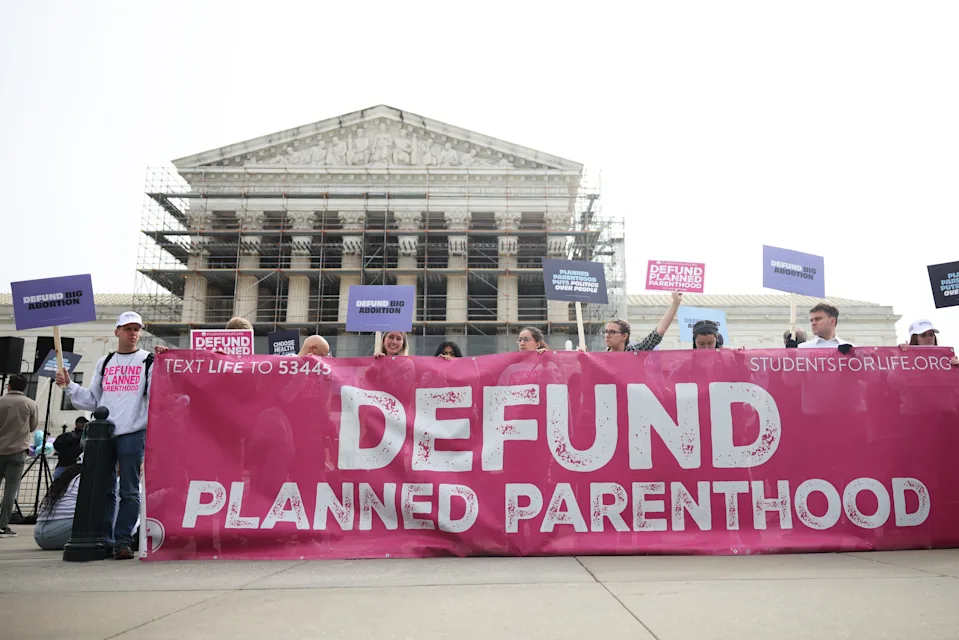Washington, D.C., June 2025 —
The U.S. Supreme Court was the center of national attention this week as demonstrators gathered outside its doors, rallying in response to the Planned Parenthood funding case currently under review. The case, which could significantly impact how federal and state funds are distributed to healthcare providers like Planned Parenthood, has sparked intense emotions across the country.
Activists from both sides of the debate – pro-choice and pro-life – arrived in large numbers, holding signs, chanting slogans, and sharing personal stories. The atmosphere was tense yet peaceful, filled with passion and concern about what the outcome could mean for the future of reproductive health access in America.
Why the Planned Parenthood Funding Case Matters
The Planned Parenthood funding case being reviewed by the Supreme Court centers around whether states have the right to exclude Planned Parenthood from Medicaid programs, even when the organization provides services unrelated to abortion.
This case stems from multiple legal battles in states like Texas, Louisiana, and Arkansas, where lawmakers moved to cut Medicaid funds from Planned Parenthood. Their justification? Claims that the organization engages in unethical practices. Planned Parenthood, however, denies all allegations and argues that these moves are politically motivated efforts to dismantle women’s access to essential health services.
If the Supreme Court rules in favor of the states, millions of low-income Americans could lose access to healthcare services such as:
- Cancer screenings
- STD testing and treatment
- Birth control
- General health checkups
- Prenatal and postnatal care
The ruling could set a nationwide precedent, potentially allowing other states to follow suit.

Scenes From the Steps of the Supreme Court
As the court convened, crowds began gathering early in the morning. Demonstrators came from across the country. Some were seasoned activists, while others were first-timers drawn by personal experience or concern.
“I wouldn’t be alive if not for Planned Parenthood,” said Mariah Green, 29, from Ohio. “I was able to get a cancer screening when I had no insurance. This isn’t just about abortion. It’s about healthcare.”
Others stood in opposition. “Taxpayers shouldn’t fund an organization that performs abortions,” said Jake Dawson, 42, from Alabama, holding a “Defund Planned Parenthood” sign.
Despite the emotional divide, the protest remained largely respectful. Police maintained a strong presence to ensure order. There were musical performances, passionate speeches, and moments of silence for those whose lives had been affected by lack of access to care.
A Closer Look at the Legal Arguments
At the heart of the Planned Parenthood funding case is whether individuals have the right to challenge a state’s decision to disqualify a healthcare provider from Medicaid. Several lower courts have ruled that patients do have that right. Other courts disagreed, leading to legal confusion that only the Supreme Court can resolve.
Key Legal Questions:
- Can Medicaid patients sue states for removing healthcare providers from the program?
- Do states have legal grounds to defund Planned Parenthood?
- Is this an issue of healthcare or politics?
Planned Parenthood’s legal team argues that denying people the right to choose their healthcare provider goes against federal Medicaid laws. On the other side, state attorneys argue that states should have discretion over how public funds are allocated.
How the Public Reacted Nationwide
As the case gained media attention, reactions spread far beyond Washington. Social media platforms were flooded with hashtags like #StandWithPP and #DefundPP. Celebrities, politicians, and influencers joined the conversation.
Vice President Linda Suarez tweeted:
“Healthcare is a human right. The Supreme Court must protect access for all Americans. #PlannedParenthood #HealthcareForAll”
Senator Mark Hollins (R-TX) responded:
“States should be allowed to make funding decisions based on values and facts. The Court has a duty to uphold that right.”
Opinion polls show a nation divided. A Pew Research survey conducted last month revealed that:
- 56% of Americans support continued funding of Planned Parenthood.
- 38% support defunding.
- 6% remain undecided.
What’s at Stake for Millions of Americans
For many low-income individuals, Planned Parenthood is one of the few affordable healthcare providers in their area. According to the Guttmacher Institute, over 60% of Planned Parenthood patients rely on Medicaid or public assistance.
If the Supreme Court sides with the states:
- Thousands of women could lose access to birth control.
- Cancer screenings may become harder to access in rural and underserved areas.
- Preventive healthcare could decline, leading to increased emergency room visits.
Healthcare experts warn that the long-term effects could lead to greater disparities in health outcomes, especially among marginalized communities.
Voices from the Ground
Throughout the day, reporters spoke with dozens of demonstrators. Some were emotional, some angry, and many were simply hopeful that their presence would make a difference.
Stories From Protesters:
Anna Rodriguez, 33, from New Mexico:
“When I was 19, I found a lump in my breast. I went to Planned Parenthood because I had no insurance. They helped me catch cancer early. That saved my life.”
Tyrell Johnson, 21, from Georgia:
“I’m here because my sister couldn’t get birth control when our local clinic shut down. She’s now raising a child she wasn’t ready for. This is real.”
Susan Blake, 59, a pro-life advocate from Kentucky:
“I’m here to support unborn lives. But I believe we need to offer better alternatives for women’s health, not just cut funding.”
What Happens Next?
The Supreme Court is expected to issue a ruling later this year. Until then, both sides are preparing for possible outcomes.
If Planned Parenthood wins, the organization will continue receiving Medicaid funding in states that have tried to cut it. A ruling in favor of the states, however, could open the door for other conservative-led states to follow the same path.
Planned Parenthood President Alexis McGill Johnson released a statement saying,
“Our doors remain open, and we will continue to fight for every person’s right to healthcare, no matter what the Supreme Court decides.”
Meanwhile, lawmakers are preparing legislative responses, and nonprofit organizations are ramping up campaigns to spread awareness about what’s at stake.
Conclusion: More Than Just a Court Case
The Planned Parenthood funding case represents more than a legal fight. It’s a reflection of deep social and political divides in the U.S. – about who has access to healthcare, how public funds should be used, and what role the government should play in people’s private medical decisions.
For many Americans, this decision will have real-life consequences. It’s not just about a building in Washington D.C. It’s about clinics in small towns, people in underserved communities, and the fundamental belief in the right to choose your healthcare provider.
As the nation waits for the final ruling, one thing is clear – this case has already sparked a conversation that won’t be ending anytime soon.
Read Next – Trump Tax Bill Student Loan Exemption: What It Means for You






